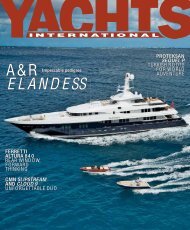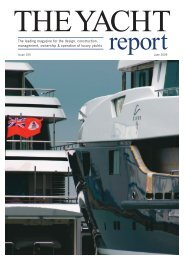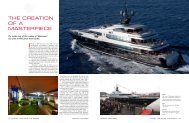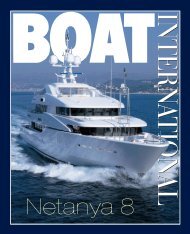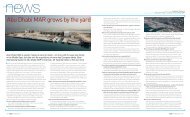SuperYacht Business - February 2009 - CMN Yacht Division
SuperYacht Business - February 2009 - CMN Yacht Division
SuperYacht Business - February 2009 - CMN Yacht Division
Create successful ePaper yourself
Turn your PDF publications into a flip-book with our unique Google optimized e-Paper software.
SUPERYACHT BUSINESS ◗ NEW-BUILD ROUND-UP: GERMANY | ◗ LUCA BASSANI | ◗ THE SPECIALISTS: LAWYERS | ◗ YARD INSIGHT: <strong>CMN</strong> YACHTS FEBRUARY <strong>2009</strong> | ISSUE 8Issue 8 | <strong>February</strong> <strong>2009</strong>Old timerHistoric performanceand precision in aclassic chronometerIndustry insight for decision makerstaxAvoiding theinspe ctor+Legal eaglesLawyers reveal thechallenges of complexmodern contractsWally’s wayBassani on how his firmhas changed the waywe buy — and sailFlags at warWill Belize’s move intoopen registry break upglobal conventions?www.superyachtbusiness.netOyster entryEd Dubois helps push theUK sailboat builder intobig-yacht sectorFull report on the EU’s cross-border investigationsinto superyacht ownership — and how it intendsto pursue and recover its long-lost VAT revenueGerman biteUpdate on the yardssecuring the nation’sshare of the market
YARD INSIGHT<strong>CMN</strong> FRANCENavydisciplinesSince WWII Cherbourg-based <strong>CMN</strong> has built more than 300craft up to 70m (230ft). It still builds military vessels andsuperyachts and, since 1994, has converted and refittedsome of the largest motoryachts in EuropeThe story of warship buildersdiversifying into superyachtshas not always been a happyone. Two well-known Britishshipbuilders, DevonportManagement Limited (DML)and VT Shipbuilding, who believed they couldconstruct refined superyachts as easily as theycould sub-hunters or destroyers, seriouslyunderestimated the extensive differences inthe business cultures and customerexpectations. Having leapt with both feet intothe big-yacht market during the past decade,66 WWW.SUPERYACHTBUSINESS.NET | FEBRUARY <strong>2009</strong>THE MOVE INTO YACHTS FROM COMMERCIAL WORK HAS OFTENPROVED DIFFICULT. NOW <strong>CMN</strong> IN CHERBOURG BELIEVES IT HASLEARNED THE RIGHT LESSONS FROM ITS MILITARY EXPERIENCEBOB GREENWOOD REPORTSboth have since decided to get out — VT afterit had launched Mirabella V, the world’slargest-ever sailing sloop five years ago, andBabcock Marine (now owner of DML) whichannounced last October that it wasn’t going totake on any new yacht contracts.In France, however, <strong>CMN</strong> (ConstructionsMécaniques de Normandie) has shown thatthe marriage of the two unlikely disciplines,warships and superyachts, can work — andwork well. In addition more than 50 years ofbuilding patrol vessels, minesweepers andwarships up to 70m (230ft) and beyond,the yard in Cherbourg also builds France’slargest motoryachts.In-house skillsCentral to business plans in the yachtingsector is the <strong>CMN</strong> Line 60 — a line of 60m(197ft) yachts based on displacement steelhulls and sporting tri-deck aluminiumsuperstructures. The naval architecture forthese has been done in house, overseen bya dedicated <strong>CMN</strong> <strong>Yacht</strong> management teamwhich makes full use of the considerableexpertise of up to 80 engineers all wellPlasma-cut handiworkaccustomed to meeting the rigorous demandsof <strong>CMN</strong>’s military clients. “The navalarchitecture that goes into our yachts is 100 percent <strong>CMN</strong>,” explains Cyril Le Sourd, <strong>CMN</strong> <strong>Yacht</strong>’sproduct manager. “It includes everything fromstability calculation and hotel load calculation toweight estimates and all follow-ups.”The yacht team also draws on an in-housetrade skill base built up over more than fivedecades. These include all electrical andelectronics systems installation, carpentry,hydraulics, plumbing and pipe makingactivities. The fact that <strong>CMN</strong> is a majorTOPVIEW PIERRE BALMER, CHAIRMAN & CEOworked at<strong>CMN</strong> for 20 years, asindustrial managerand then chairman,‘HavingI’ve been involved inour move into thelarge motoryacht market from the start. Icame to <strong>CMN</strong> from the French defenceministry and since then, even with theongoing conflicts in the Middle Eastproviding steady business, I could see itwouldn’t be good for <strong>CMN</strong> to rely solely onthe military market.We saw that the market for largeyachts was very active, but also thatit had a very different culture from themilitary sector. Strong competition fromestablished players was never going tomake it easy for newcomers to break into,and sustain, a strong position without alot of preparation. But I was convincedabout building yachts because I knew wewould be good at it. And I’m pleased to saywe were able to convince our owner too.Ten years ago we created the <strong>CMN</strong><strong>Yacht</strong>s division to develop this business.Now we are fully conversant with theculture of the yacht market and arerecognised by the big brokers and haveworked on new-builds with the likes ofFraser <strong>Yacht</strong>s, Burgess <strong>Yacht</strong>s and Camper& Nicholsons International.We intend to be increasingly active onthe yacht side. Our traditional strengthhas been in the warship and patrol craftmarket which has accounted for about 70per cent of our business — although atthis moment, with two 60m (197ft) yachtsin build and a third just started, alongwith a 72m (236ft) frigate in the yard, youcould say that 70 per cent of our activityis superyachts. In three to five yearstime, however, I would like to see an equalturnover split between naval and yachtactivity. Our aim is to build one militaryproject lasting three to five years andhave 1.5 yachts in build every two years.We don’t want to go the same way asother naval yards, such as Vospers andPierre Balmer, CEO and chairman, <strong>CMN</strong>:“Although the military culture is completelydifferent we plan to do more big-yachts”DML, who jumped in and then jumped outof the yacht market. We intend to stay.Our main strength is in being goodmanagers and designers who can buildships with added value. We’ve shown thisfor more than 50 years, ever since westopped building Amiot military aircraftand started building fishing boats.Specifically, we have very goodnaval architecture skills. We are good atintegrating systems and equipment — andwe know how to manage programmes.We are on time with 95 per cent ofscheduled delivery and we are awarethat we must continue to increase ourefficiency on cost and price. With ourtwo most recent Line 60 builds we havebeen able to reduce recurrent engineeringcosts by 10-15 per cent.What is lacking generally in thesuperyacht market is industrial process— an area where we are strong.Looking ahead, I’m certainly notpessimistic. Customers are holding back,but confidence will return globally whenthey have evaluated their real financialpotential. We feel that the top end ofthe market is the most secure. When themarket picks up again, you can be sure wewill be ready to respond.’“We intend to increase yacht activity.Our traditional strength has been warships butin five years I want to see an equal splitbetween naval and yacht production”FEBRUARY <strong>2009</strong> | WWW.SUPERYACHTBUSINESS.NET 67
YARD INSIGHT<strong>CMN</strong> FRANCESTRAIGHT SEAMSSYNCHRONISED FARINGCatia 3D CAD-CAM software andplasma cutting means <strong>CMN</strong> canproduce steel and aluminiumplates to exact dimensions.It produces neat and tidywelded seams during hull andsuperstructure construction.Left: A Line 60 virtual engine room.Every system — from engines and plumbingto electrics and hydraulics — is painstakinglyfitted together on screen ahead of the build.Component manufacturers now provide theirown 3D digital technical drawings but <strong>CMN</strong>redraws everything so that unneeded detailis stripped away and memory load reducedAs hull and superstructure panelsand weld seams are so accurate,little faring is needed to produce asmooth finish, although dark hullsrequire much more because theyshow the slightest blemishes.stainless steel pipework contractor to theFrench nuclear power industry says much forthe quality of its work. “About the only workwe don’t do ourselves is the painting andstainless steel polishing,” says Le Sourd.The steel hulls are built in five sectionsthat have services installed before they’rewelded together ready for the aluminium deckand superstructures to be superimposed.Computer designAll departments share interactive use of themost powerful 3D CAD-CAM system tools intoday’s industry — Circe and Catia softwaredeveloped by French avionics systems groupDassault and primarily used in the automotiveand aerospace industries. The designdepartment uses the latest V5 version of Catiabut a programme is underway to introduce thisfrom design through to manufacturing, which iscurrently using the V4 version.All exterior and interior design — byLondon-based Andrew Winch Designs — isintegrated with the naval architecture on theV5 system. The <strong>CMN</strong>/Winch combinationallows wide scope for customisation. Since2007, four <strong>CMN</strong> yachts have been ordered and,while all are sister ships, each is distinctive inits own way. Cosmetically, they are certainlydifferent. The first and so far only Line 60 tohave been delivered — Netanya 8 — has aclassic white hull and superstructure<strong>CMN</strong> is the first superyacht yard to use Circe-Catia-Rimbaud CAD-CAM software usuallyused in the car and aerospace industries.The latest V5 version of Catia 3D allowsdesigner to generate exceptionally clear andaccurate 3D working drawings as well as lifelikerenderingscomplemented by a light wood interior.Launched in <strong>February</strong> 2007 she will befollowed by Slipstream and Cloud 9, whichlaunch in March and April <strong>2009</strong> respectively.“Slipstream and Cloud 9 are evolutions ofNetanya 8, with a longer and deeper hullcreating a full-height ‘bilge deck’ under guestand crew accommodation,” says Le Sourd.“The exterior style has now been modifiedThierry Regnault, <strong>CMN</strong> <strong>Yacht</strong>s deputymanager, discusses an engineering detail ona Line 60 yacht with a member of the yard’sdesign team. For an engineering-driven builderlike <strong>CMN</strong>, Catia 3D is a vital communicationtool linking all disciplines from design tofinishingwith vertical windows for the wheelhouse andthe panoramic lounge of the owner’s suite. Apanoramic dining room has been added aft ofthe bridge deck lounge.”Slipstream will have a dramatic appearancedefining her from others in the series with ablack hull and silver-grey superstructure,while Cloud 9 will be more classic with a navyblue hull and white superstructure.”PACKING THEM INAll ducting, trunking, cablingand pipework is foil insulated forthermal regulation and to deadensound before it’s hidden awaybehind facing panels. Plumbing andelectrical systems are installed bythe yard’s own tradesmen. Use ofsubcontractors is minimal. <strong>CMN</strong>’s400 employees do everythingexcept painting and polishing.“Slipstream and Cloud 9 are evolutionsof Netanya 8, with a longer and deeper hullcreating a full-height bilge deck under guest andcrew accommodation”Internally, too, the difference is remarkable.Slipstream is neo-Art Deco with ebony and redleather joinery and panelling while Cloud 9 ismuch lighter and described as ‘beach house’.Work started in <strong>February</strong> on hull 803, thefourth Line 60 ordered to date, with thecutting of the steel plates and the start of theconstruction of the central hull section.Delivery is scheduled for the end of 2011.As Thierry Regnault, <strong>CMN</strong> <strong>Yacht</strong>s’ deputymanager points out, painting is a major factorin delivery schedules: “With a standard whitehull we would expect to complete a Line 60 intwo years. A black hull and metallic greysuperstructure, such as Slipstream’s, can addthree months to that because dark hullsLarge steel plates are fabricated withdifferent welding techniques and are thentested for deflection. The plate shown has ameasured deflection at the centre of no morethan 3mm68 WWW.SUPERYACHTBUSINESS.NET | FEBRUARY <strong>2009</strong>FEBRUARY <strong>2009</strong> | WWW.SUPERYACHTBUSINESS.NET 69
YARD INSIGHT<strong>CMN</strong> FRANCESTAIRWAY TO HEAVENCentral spiral staircases are acommon theme of the AndrewWinch Designs interiors. This onelinks all five decks of Netanya 8.ROOM WITH A VIEWThe Line 60 yachts from the <strong>CMN</strong>yard are all designed to be ableto comfortably accommodate anowner’s party of up to 12 guests.On Netanya 8 it means that theVIP cabin has been equippedwith its own private balcony,which has been positioned on thebridge deck.VERSATILE DESIGNThe wide-body, high-volumedhull form of the Line 60 yachtshelps the <strong>CMN</strong> teams to fullymaximise all customised optionsfor accommodation layouts.The airy and spacious mainsaloon of the Line 60 Netanya 8demonstrates this principlein practice.Launched in <strong>February</strong> 2007, Netanya 8 wasthe first Line 60 to be completed. The seriesis now the main focus of <strong>CMN</strong>’s yacht divisionand two more are being fitted out while workhas started on a fourthshow the slightest blemish and need extrafairing and varnishing. Although our weldingis of a very high standard and our hullsrequire little faring, black is very unforgiving.”When SB visited the 400-employee <strong>CMN</strong>yard in mid-January Cloud 9 occupied theyard’s main 270m (886ft)-long constructionhall along side a 72m (236ft) naval frigateunder construction for Abu Dhabi. With aheight restriction of 18m (59ft), the frigate isabout the largest vessel that the yard is ableto build. When complete, she and the yachtswill be launched using the yard’s 3,500 tonnecapacitySyncrolift.The yard has its own slip but prefers tolaunch larger vessels this way. “It’s gentler,”says Le Sourd. “We don’t like to risk the platedistortion that can occur with slip launching.”Unlike other warship yards, <strong>CMN</strong> is inyacht building for the long haul. Its close tiewith the yachting market goes back to the1960s when it started the series building ofthe Illingworth and Primrose-designed 11m(36ft) Maïca sailing yachts cold moulded inmarine ply. It then added compositelamination to its list of skills which alreadyincluded steel and aluminium construction. Inthe 1970s it was responsible for constructingsome of the most notable racing yachts of theera, including sailing legend Eric Tabarly’s16.5 tonne aluminium trimaran Paul Ricard“We regard our main competition as thetop German and Dutch yards. We intend to buildeven bigger — and have the capacity to go up to70m. Few others can build as large as us”and Route de Rhum winner, also a trimaran,Kriter IV for Olivier de Kersauzon, as well asthe aluminium ice-breaking ketch Antarctica,built for exploration work in 1989.Carbon laminates<strong>CMN</strong> can also claim to have been the Frenchpioneer of hull and deck lamination usinghigh temperature-cured prepreg epoxy carbon/e-glass laminates, having moulded the firstWhitbread Round the World 70ft (21m) racingyacht Milène by this method as far back as1983. However, the composite moulding sideTop: ‘Band Shell’, a 12m (39ft)-high aluminiumwork by designer Martin Francis built at <strong>CMN</strong>’syard. Below: The management team (l-r): CyrilLe Sourd, Mathieu Koechlin (project managers)and Thierry Regnault (deputy manager)of the business was separated from <strong>CMN</strong>’smainstream steel and aluminium constructionbusiness in 1992 when it formed a newcompany with Jean-Marie Vaur, previously<strong>CMN</strong>’s lamination department manager. <strong>CMN</strong>/JMV Industries, which occupies a factoryadjacent to the main shipbuilding area on the150,000m 2 <strong>CMN</strong> site, is 70 per cent owned by<strong>CMN</strong> group’s owners, Triacorp, a privateholding owned by the SAFA group. Triacorp isalso involved in real estate and projectdevelopment in Europe and the Middle East.Displacement craftSince it became a <strong>CMN</strong> daughter company,JMV has developed its own business as a leadplayer in racing yacht and mast construction,using epoxy-carbon prepregs. It built severalof the IMOCA Open 60 racing yachts used inmore than one of the Vendée Globe singlehanded,non-stop round the world races,including the 2008/<strong>2009</strong> edition. Other bigprojects include work as a subcontractor on the140ft (43m), Phillipe Briand-designed racingschooner Mari Cha IV, and the 40m (131ft)trimaran racer Banque Populaire V.<strong>CMN</strong> remains a major JMV client,however. Recent projects include an e-glassepoxy deck and superstructure for thealuminium-hulled 32m (105ft) catamaranLady Barbaretta launched in 2003 and ownedby Sir Richard Branson.By the early 2000s <strong>CMN</strong> <strong>Yacht</strong>s’ main focushad switched to large displacementmotoryachts. Before beginning the Line 60projects, the yard had done extensive refit andconversion work on the 49m (161ft) FrenchLook, 34m (112ft) Anata and 34m (112ft) AlterEgo — all expedition motoryachts. The firstlarge motoryacht job that <strong>CMN</strong> took on,however, was Bermie II, at 49m (161ft), in2001. The hull was constructed in South Africaby Oceanco. “They didn’t have a buyer, but wedid. So we took it over,” says Cyril Le Sourd.That was followed by the 42m (138ft)Héloval, with exterior and interior styling byJoël Brétécher/Stirling Design, then Netanya 8.Large yachts account for one third of anannual turnover of around 170m.With its extensive yacht-build backcatalogue <strong>CMN</strong> demonstrates how, withunderstanding and technical expertise, it’sperfectly possible to build hi-tech, austerelyfinished military vessels alongside swishsuperyachts — and to the advantage of both.“Our main competition are the top Germanand Dutch yards,” says Le Sourd. “We intendto build even bigger and have the capacity togo up to 70m (230ft). Few others can build aslarge as us and, we maintain, as efficiently.”Prices and delivery times are attractive too,with the average price for a <strong>CMN</strong> Line 60coming in at 155m and delivery two yearsfrom receipt of order.70 WWW.SUPERYACHTBUSINESS.NET | FEBRUARY <strong>2009</strong>FEBRUARY <strong>2009</strong> | WWW.SUPERYACHTBUSINESS.NET 71
YARD INSIGHT<strong>CMN</strong> FRANCE<strong>CMN</strong> LINE 60 SPECIFICATIONSTECHNICAL DETAILS◗ LOA: 60.00m (196ft 10in)◗ Beam: 11.10m (36ft 5in)◗ Draught: 3.45m (11ft 4in)◗ GRT: 1,085 tonnes◗ Fuel: 131,700lt (34,606 US gals)◗ Fresh water: 29,000lt (7,661 US gals)◗ Stabilizers: Zero speed Quantum ZS1500 — four blades◗ Main engines: 2 x 2,230hp Caterpillar3516 B◗ Max speed: 15.5kt◗ Cruise speed: 14.5kt◗ Range @ 11.5 knots: 5,000nm◗ Guests: 14◗ Crew: 12-16◗ Construction: steel/aluminium◗ Engineering: <strong>CMN</strong>◗ Design: Andrew Winch Designs◗ Classification: Bureau Veritas<strong>CMN</strong> YACHTS LAUNCHEDMOTORYACHTSYear Name Type Length1994 French Look Expedition motoryacht 49m (Conversion)1999 Ananta Expedition motoryacht 34m (Refit)2001 Alter Ego Expedition motoryacht 34m (Refit)2001 Bermie II Motoryacht 49m2002 Héloval Motoryacht 42m2007 Netanya 8 Motoryacht 58m<strong>CMN</strong> LINE 60 MOTORYACHTS UNDER CONSTRUCTIONFeb <strong>2009</strong> Slipstream Motoryacht 60mJun <strong>2009</strong> Cloud 9 Motoryacht 60m2011 Project 803 Motoryacht 60mSAILING YACHTSYear Name Type Length1978 Kriter IV Trimaran 23m1980 Paul Ricard Hydrofoil trimaran 17m1981 Jacques Ribourel Trimaran 23m1984 Entreprise Racing monohull 14m1985 Milène Racing monohull 24m1994 Friday Star Monohull 42m2003 Lady Barbaretta Catamaran 32m2003 Attimo Monohull 32m(Sailing yachts are now built in prepreg composites by JMV, <strong>CMN</strong>’s daughter company formed in 1992)72 WWW.SUPERYACHTBUSINESS.NET | FEBRUARY <strong>2009</strong>



